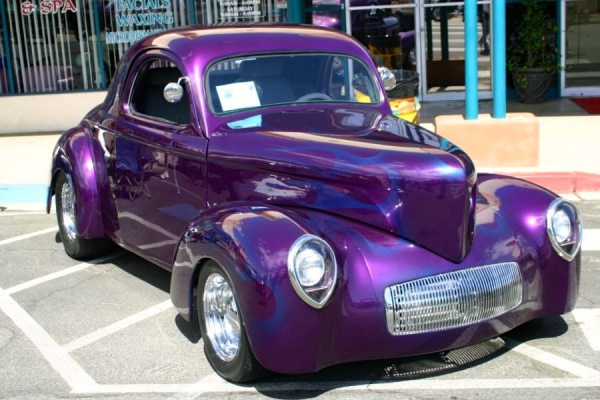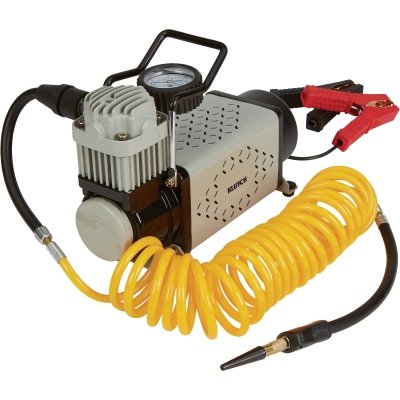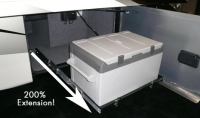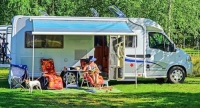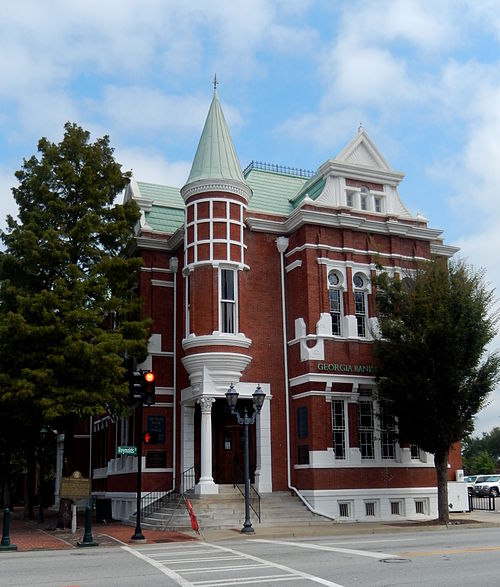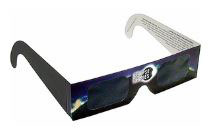Welcome to Crossing Creeks RV Resort & Spa in the heart of iconic Blairsville
Nothing turns your head faster and farther than beauty—an old car that’s dressed to the nines. OK, almost nothing. But classic and custom cars do beg for your attention, and thousands—seriously, thousands— will be on display at car shows throughout Georgia during 2018, all an easy drive from Crossing Creeks RV Resort & Spa in Blairsville.
Car shows begin in earnest in April and May. Many are spring, summer or fall events. One of Georgia’s shows claims that it’s the world’s largest monthly show, running even through the winter.
Car shows in Georgia offer a chance to view a wide variety of vehicles:
- Classics, which are at least 30 years old and maintained in or restored to original condition, ranging from sports cars to family sedans.
- Hot rods, which are customized cars built between 1920 and 1948, usually chrome-laden, impeccably finished and powerful.
- Rat rods, the same age as hot rods and similarly customized for power, but often made to look unfinished or even worn—“ratted out.”
- Street rods, which are built for reliable cruising, with more power amenities than hot rods, even air conditioning.
- Muscle cars, which originated in the 1960s with the Pontiac GTO and include pony cars, named after the Ford Mustang.
- Tuner cars, which are recent and current models, mostly foreign marques, and often Volkswagens and Audis, with power bolstered by electronic tuning and turbochargers.
- Motorcycles and, occasionally, tractors.
Choose a show that attracts the type of vehicles you love. If you have kids, the tuner car shows, with cars like the ones in the “The Fast and The Furious” movies, might be a good way to hold their interest.
Car shows in Georgia include not only annual displays, but also monthly or even weekly gatherings.

Upcoming Shows
In its 73rd year is the Pine Tree Festival Car Sow at Main Street Market, Swainsboro, on May 5. It’s sponsored by South Georgia Car Shows, whose facebook page lists other automotive showcases in Georgia. Check out Pine Tree on facebook, too. Cars run the gamut, from old through the muscle era to today’s performance cars. Attendance is free.
Events often combine philanthropy and cars. An example is the annual Exchange Club of Wayne County Benefit Car Show on June 9 at Wayne Memorial Hospital in Jessup. Sponsored by Wayne County Cruisers, the show helps to fund the Exchange Club’s charities. It features nine judged categories, including trucks, rods, motorcycles and tractors, and awards the top choices of attendees.
Some shows run monthly. Caffeine and Octane (is there a difference?) showcases cars on the first Sunday of every month year round in Dunwoody, north of Atlanta. It bills itself as the world’s largest monthly car show. The shows, which contribute to an NBCSN TV series, are at Perimeter Mall. It’s free—even entering a car is free. It’s also early: 8-11 a.m. On display are classics, muscle cars, modern performance cars, imports, exotics, rare vehicles and motorcycles. There are plenty of places to eat and grab a drink, including morning coffee.
Atlanta has several other shows, including a couple that combine fashion and rolling metal. Check eventbrite.com.
There are too many car shows to list. Just Google car shows Georgia and you’ll find plenty more. If you want to take the motorhome out and really travel, SoutherTravelGuide.net has a Southern states car show list.
By the way, we haven’t found one yet that judges RVs, but you never know.

To protect your valuables when you’re away from your RV, any of several security measures—or a combination—can help without breaking the bank.
At Crossing Creeks RV Resort, you rest easy because the park has security, you know your neighbors, and they know you. But what about when you’re on the road?
Any of the following will enhance RV security:
Security System
The cost of an effective security system has dropped. It’s possible to get a motion detector that automatically alerts a monitoring service, police or you when it detects a break-in. The best systems, when they detect a break-in, place a cell call automatically.
The Tattletale, for instance, sits on a desktop or counter and is battery powered. It has a built-in motion detector and optional exterior detectors. Everything is wireless. It can be set to prevent false alarms from pets.
Price: $400, plus $21-$29 monthly for monitoring.
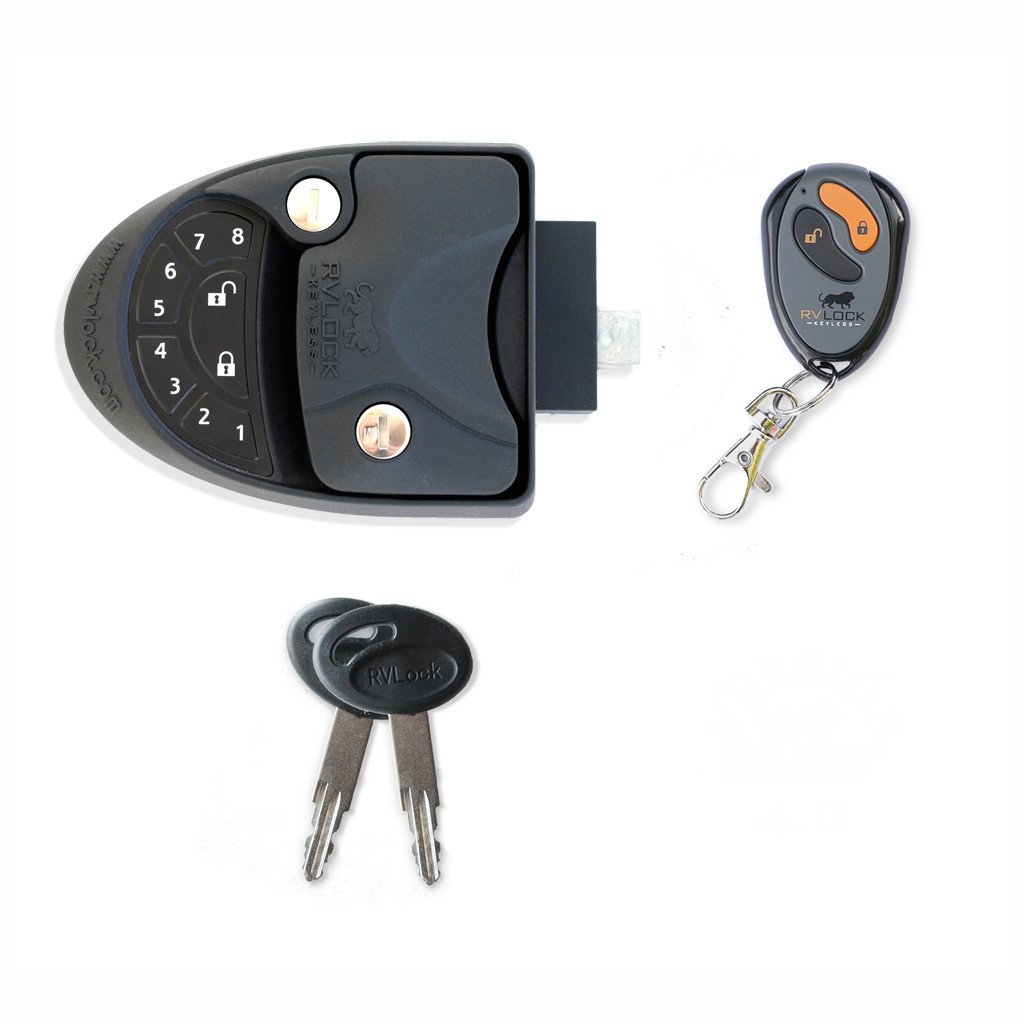
Motion-Sensing Exterior Lights
If someone approaches the RV, the infrared-detecting fixture senses the heat given off by the body and lights up. Intruders don’t want to be seen, and sometimes this is enough to discourage them. Installation and connection to the 12-volt electrical system is simple. Some models are battery-powered. Look for one that blinks to warn of a low battery.
Price: $30-$60
Solenoid-Operated Deadbolts
It’s not hard to come up with a key that will open another RV: Manufacturers make only a few unique key cuts and tumblers. That makes locks on an RV more vulnerable than those on your home.
Much stronger than standard RV door latches are solenoid-operated deadbolts. They also are more difficult to override. Solenoid deadbolts need electrical power. Some are hard-wired with contacts on the door and doorframe. Others use batteries, which you would need to replace from the inside yearly. Solenoid locks open either with a keypad on the outside of the door, or by buttons on a pocket fob—perfect when your hands are full of groceries. You set the combination, so the chances that an intruder can steal the code are slight.
You must choose a model that will fit your door.
Price: $150-250
A Dog
Sound corny? Don’t pooh-pooh it. A dog that is protective of its turf and barks at the sound of someone outside the RV actually is quite a deterrent.
He doesn’t have to be big and ferocious, but it helps if he sounds that way. A “Beware of Dog” sign doesn’t hurt. The downside: The interior must be cool enough so that the dog’s health isn’t threatened, and the time you’re away is limited by his bodily demands. Still, a dog is effective. You’ll have to train, feed and groom a dog, but he’ll repay you in companionship, in addition to guard duty.
Price: Variable; adopting cuts your purchase cost.

Wheel, Hitch Locks
If you’re worried about your RV itself being stolen, try a wheel lock. A boot type lock prevents the wheel from turning and blocks access to the lug nuts, the same way a boot prevents movement of a parking ticket scofflaw’s vehicle. A hitch lock prevents hooking up to your hitch ball.
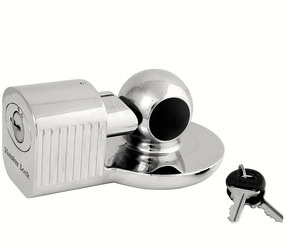
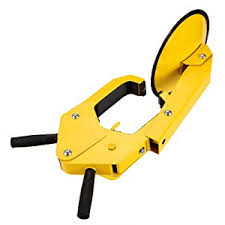
Price: $30-$60
Columbus, GA, provides a wealth of history and touring opportunities for visitors, and though you might not expect it, excellent whitewater sports on the Chattahoochee River.
The city of about 190,000 lies across the river from Alabama in southwest Georgia. It’s an easy drive of about 3½ hours by Interstate 85 south, or by taking the scenic route over Georgia 515 West.
Columbus, named after the explorer, was a native American trading center, then an industrial center since before the Civil War. The war’s last significant battle, between armies commanded by Union Gen. James H. Wilson and Confederate Gen. Joseph E. Johnston, was fought in and near Columbus. Johnston’s army actually capitulated after Gen. Robert E. Lee surrendered his Army of Northern Virginia to Union Gen. U.S. Grant. Among the wounded: chemist John S. Pemberton of Columbus, said to have developed the recipe for Coca-Cola as part of his recuperation.
Columbus is along the fall line, where mountains north and west of the city spill their river waters onto the plains that run from Columbus to the Atlantic Ocean.
Some things to do in Columbus:
Military Museums
Columbus is the home of the Army’s Fort Benning, which trains infantry. It’s only fitting that the city also contains the National Infantry Museum and Soldier Center, adjacent to the fort entrance. See likenesses of U.S. fighting men and women in uniforms of different eras. “The Final Hundred Yards” depicts infantry warfare from eight battles.
The National Civil War Naval Museum recounts a developmental time for maritime warfare. The Civil War advanced the steamship and introduced ironclads, which were armored ships designed to deflect cannon fire. Many civil war battles were fought in and around river ports, with naval activity launched from rivers, not the Atlantic Ocean. The museum contains remnants of ships rescued from the Columbus River, and re-creations of Union and Confederate ironclads. The Water Witch is a full-size replica of a Union side wheeler captured by the Confederates; it served both sides during the war.
Columbus Riverwalk
The 15-mile Chattahoochee Riverwalk follows the river for much of its length through and adjacent to Columbus. Walk or bike the trail, from the city’s northern limits to the gate of Fort Benning and the National Infantry Museum on the south.

Black Heritage Trail
A National Recreation Trail, the Black Heritage Trail of Columbus is a walking tour that connects buildings and other places important to regional black history. The tour includes brick streets laid by slaves. The “Ma” Rainey House was the home of Gertrude Pridgett Rainey, an early-20th century recording artist and “Mother of the Blues.” Spencer High School, originally an all-black high school, was integrated in the 1970s, largely by children of Fort Benning families. Churches, libraries, cemeteries and two theaters also are on the tour. Walk, bike or skate the trail.
Urban Whitewater Sports
Columbia’s 2.5-mile whitewater rafting and kayaking course is the world’s longest urban stretch. If you dare, cross the Chattahoochee round trip between Georgia and Alabama, suspended on the Blue Heron Adventure/Whitewater Express zip line at speeds up to 40 mph.
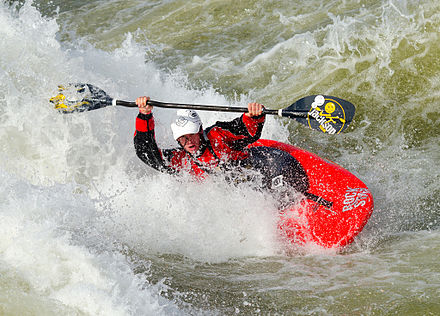
Other Columbus sights: Columbus Museum, Columbus Botanical Garden, Coca Cola Science Center, Heritage Corner.
In an RV, tools often are best if 12-volt powered, since the power circuit of your RV is 12-volt.
Here are a few good ones.
Compact vacuum


A 12-volt vacuum is a major convenience. Small, lightweight vacs are ideal when storage is at a premium. If you live in your RV only a few weeks a year, you’ll probably use the 12-volt vac to keep things tidy. Rely on a bigger vacuum that works off 110-volt house current and is stored elsewhere for thorough seasonal cleanings.
You can go a couple of different ways: A dry vac, such as the Black & Decker BDH1200FAV, or in case of spills, a compact wet/dry vac, such as the Stanley Wet/Dry 1-gallon 12-Volt Vacuum.
Price: B&D, about $35; Stanley, about $40.
Compact air compressor
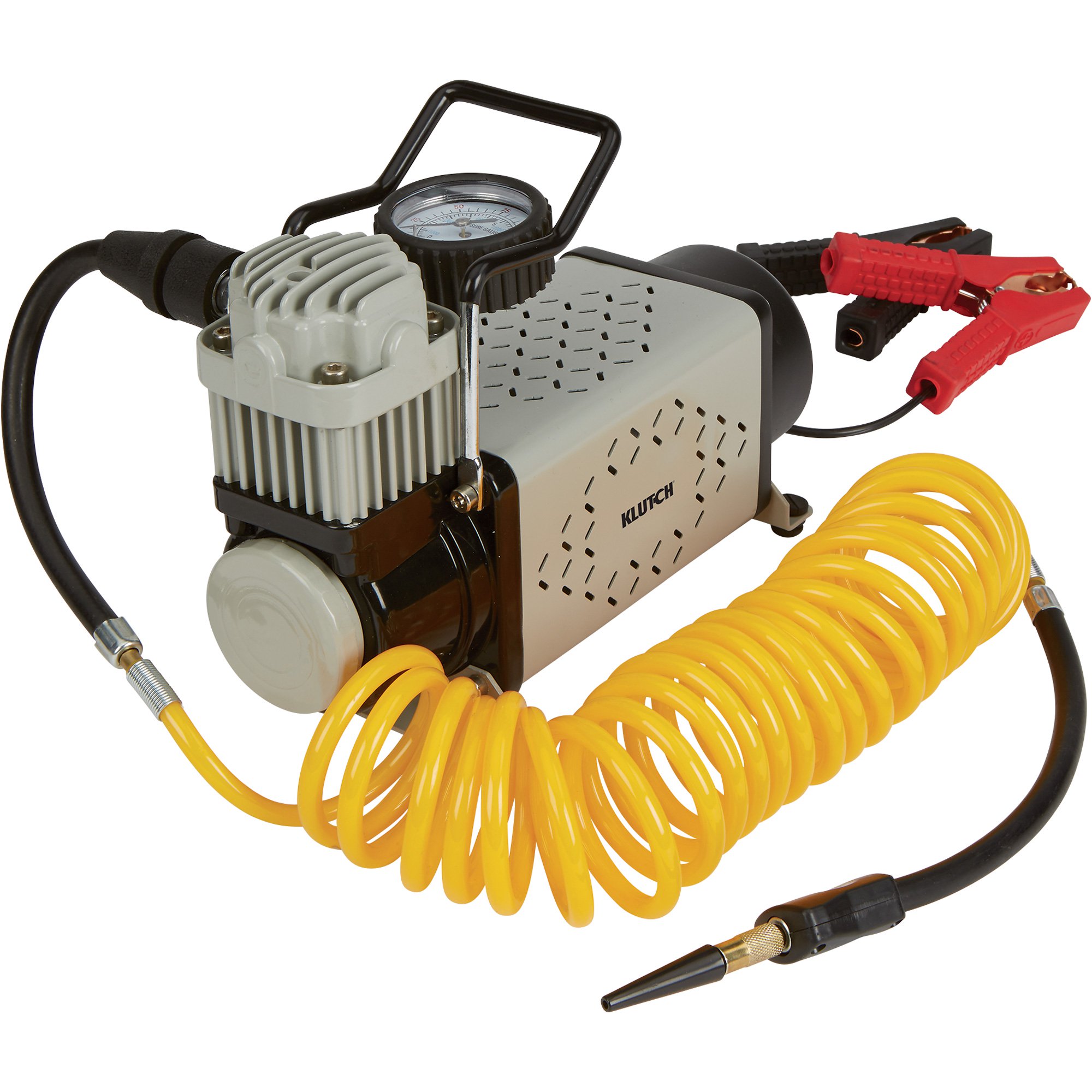
With the compressor, you can fill a compressed air tank or directly inflate a tire.
A compressor with a good compromise of capabilities, price and size is the Klutch 12-Volt High Volume Air Inflator 52509 from Northern Tool. It has a maximum 120 PSI capacity and 2.1 CFM airflow, both better than only slightly cheaper compressors. The cables with battery clips are 8 feet, and the coiled air hose extends to 16 feet, so you’ll be able to reach just about anywhere you have to. It can fill a tire on a full-size pickup in a minute, and it can run uninterrupted for 15 minutes. In its carrying case, it takes up about 1 cubic foot. Price: About $65.
Rechargeable spotlight
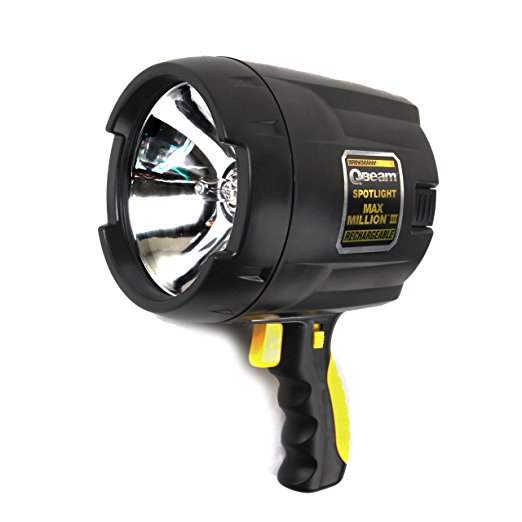
If you lose something tiny in the camper at night — an earring, maybe — or you have an emergency outside the camper, a really bright light helps. The Brinkman QBeam 800-2380-W handheld spot is rated at 1 million candlepower. It uses two lithium-ion batteries, so it’s rechargeable, meaning it doesn’t have to be tethered. It can be used while plugged into a 110-volt or 12-volt circuit. The batteries can be recharged while in the unit or while removed.
The plastic casing is tough, and the lens is tempered glass to resist breaking. The light and parts, including charger and cords, store in a vinyl bag.
Price: $69.
ThermoElectric Cooler
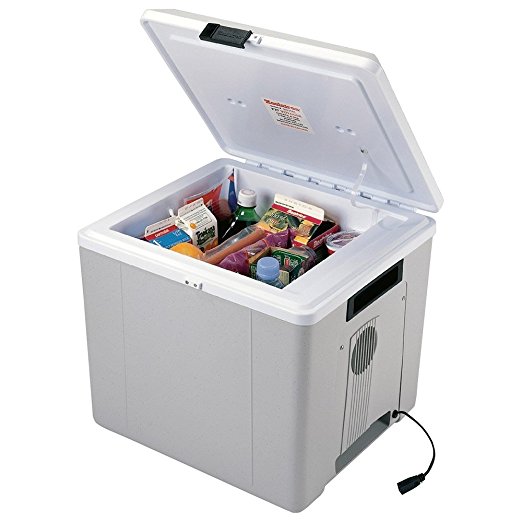
This is great if you have no refrigerator, or if your built-in refrigerator is too small. A 29-quart cooler can store two or three days of food to help keep you on the move without having to stop for restocking. Or it can hold 28 12-ounce cans; that’s a lot of beer and soda if the party ends up at your campsite. It cools to within 40 degrees of the ambient temperature.
The Koolatron Voyager Cooler doesn’t throw off a lot of heat. You can use the well-insulated fridge as a chest or as a vertical unit. The plastic casing cleans easily. It measures less than 18 inches square and weighs 13 pounds.
Price: About $120.
Some things to think about: If your product comes only with a cigarette lighter plug, or only with alligator clips for connection to a car battery, pick up the other type and an extension so you’re ready for any use. An air tank will fill a tire faster, plus it can be used with a compressed air hose to blow things clean, so add a tank if you don’t have one.
Maybe you travel as a family, and the kids are along, or maybe the grandkids are traveling to Crossing Creeks RV Resort to spend some time with you.
If they came down from the North, one of them is bound to say, “I miss snow. It’s winter. There ought to be snow.”
Hmm. Unless you travel out of state and hit a ski resort (there are none left in Georgia), that’s not likely to happen. And if you don’t ski, well ….
Go to Atlanta. Atlanta? For snow? Well, it’s not far from there.
It’s at Stone Mountain Park, about 16 miles east of the city.
The snow is made by machine, and it gets the job done. Many ski resorts on the edge of snow country make their own snow, especially in warm winters.
And what exactly do you do with manmade snow outside Atlanta?
Go snow tubing.
Tubing That Rocks
Kids love this.
The side of a hill — call it Snow Mountain, please — has lanes created in the snow, so it looks like a giant white sliding board. Starting at the top, tubers park themselves in the doughnut hole of their tubes. And off they go, down the hill — for run after run. A Snow Mountain session is two hours. You can get your own adult pass to go tubing, too. It’s a pretty gentle ride, so don’t be afraid. With the lanes separated, you won’t go bounding into other tubers, and they won’t crash into you. There are even family-sized tubes — rafts, really.
After sunset, the Snow Mountain tubing run turns into Galactic Snow Tubing. It’s along the lines of nighttime laser bowling, or spooky miniature golfing around Halloween — lights, but with snow rather than bowling lanes or putting greens. The colors on the white snow make for quite a show. Remix versions of Top 40 tunes play over the sound system, with the lights keeping time to the music.
You’ll need advance registration.
Your daily pass includes two hours of tubing, so reserve time at 4:30 or later to experience the Galactic light and sound show, which starts at 5:30.
Playing in the Snow
When they’re not tubing, kids can just play in the SnowZone, building snowmen, getting on their back to make snow angels and just plain having fun. Snow Mountain runs Nov. 8 Feb. 25.
Make sure you dress the kids appropriately. If they don’t have snow pants, layer them and get them into something warm and dry as soon as you get back into the RV. Hats, gloves and boots are all good ideas, especially the gloves.
You can get a variety of passes, some including entertainment and/or a meal, if you plan to be there for the day. There’s also a daytime Christmas exhibit. Holiday packages are available for RVers and must include an arrival or departure date that falls within Dec. 2-3, 8-10 or 15-31, and Jan. 1-3. There’s also an early New Year’s Eve party for kids on Dec. 31 that ends before midnight.
Camping includes full- and partial hookup sites, tent sites, and stationary RV and yurt rentals. Multi-day packages for RVs are available, as are in/out privileges.
Price: $31.95 to $54.95 per person (daily). Holiday RV cost (2-night stay): $159 (includes 2 single-day park passes) to $262 (4 single-day park passes), plus $15 parking fee; additional passes @$25/person. Check for snow park availability. Camp open Christmas Day, but park closed.
It’s a good time to look at gift possibilities for the RVer. Only you know best what would work for the RVer in your life — after all, you’re probably an RVer too — but here are some ideas, from leading-edge tech items to classics.
Stocking stuffer: Wineglass holder, Etsy.com
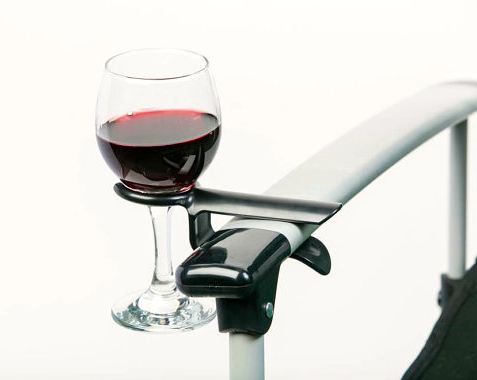
If you enjoy a little wine after dinner outside your RV, and a proper wineglass is required every bit as much as your most comfortable jeans, here’s a place to securely set down your glass. The clip-on wineglass holder works on any chair with an arm no thicker than 1 inch.
One end is a spring clip that latches securely onto the arm. The other end has plastic fingers, allowing you to slip the wineglass stem between them. The glass won’t go anywhere, which is good, since you’ll have your feet up won’t be going anywhere, either. Price: $10
RV-Compatible Grilling Set: Wayfair.com
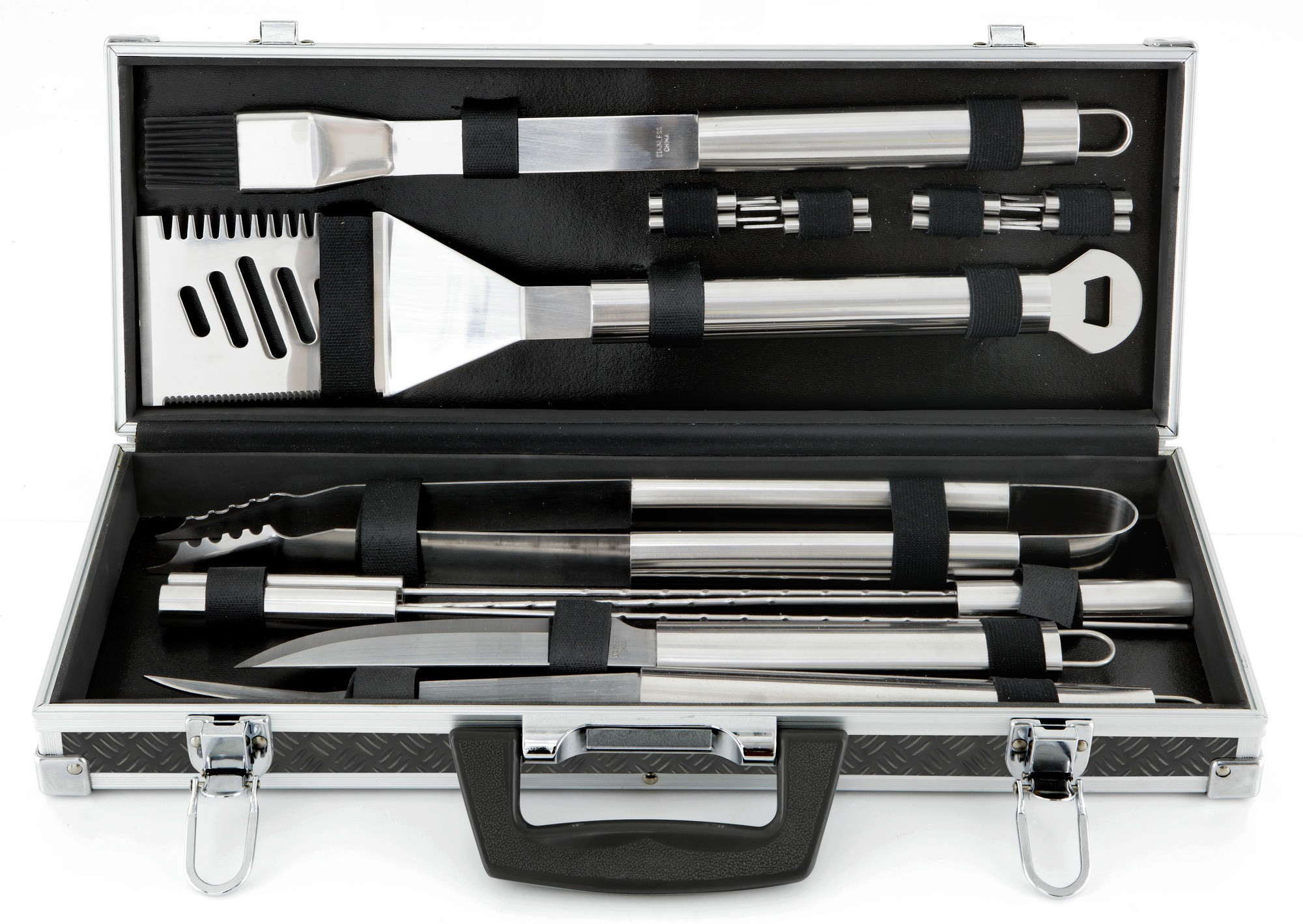
If somebody’s got to play outdoor chef — and enjoys doing it — a grilling set makes the job easier and more enjoyable. Wayfair.com has a good choice of sets, each with a compact storage case that makes RV storage easy. Some cases are hard and hinged, while others are soft and flexible. Typically you’ll find a basting brush, tongs, carving knife and fork, spatula and skewers. Some sets include steak knives, and sometimes forks, as well.
Price: $30 to $200.
Drone: DJI Mavic Pro, DroneNerds.com
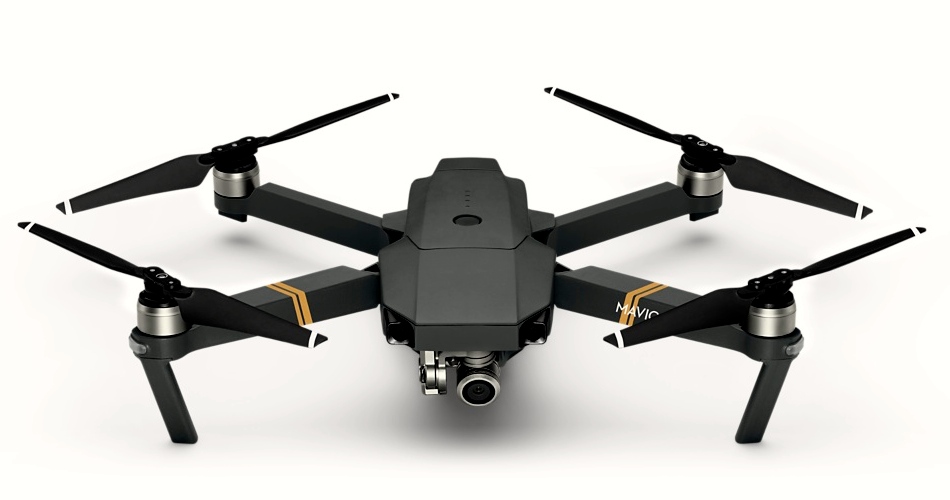
You’re taking in a fabulous view, and you think If only I could get a little higher or closer to see better. A drone does both — virtually — and shoots video at the same time. The Mavic Pro’s 4K video has four times the pixels on your 1080p TV screen. Video is shake-free because the camera is steadied by a gimbal, a small version of what stabilizes Hollywood films. Stills are 12 megapixels, and Mavic takes hands-free selfies.
The 1.6-pound Mavic Pro is great for RVs because it stores small, with foldable arms and propellers. The remote controller folds to pocket size. You see live on your smartphone what the drone sees. It has a range of 4.3 miles, and it automatically returns safely if the battery runs low. Fly over 20 minutes at up to 40 mph.
Price: $999.
Book: Travels With Charley: In Search of America, by John Steinbeck

Why recommend a book about America published 55 years ago by an author who’s since died? Well, because it documents a trip around the U.S. in a truck camper by a man and a poodle, Charley. For another, it’s by one of the country’s most celebrated writers. And it was awarded the Pulitzer Prize. For all of you who write blogs about life on the road in your RV, and all of you who wish you could, here is the original, written half a century before the Internet.
The publisher admitted more than 50 years after publication that much of this writing is fiction, but it’s interesting to read this insightful writer’s observations of the changes in America — and the fears stirred by change. Many of the problems and fears are still with us.
Price: About $6 online for a paperback, or you can spring for a rare first edition, about $110.
Slideouts that enlarge an interior room on your motorhome or trailer are almost a requirement these days, but there’s another kind of slideout that makes RV living easier: a sliding cargo tray for an external storage space.
A sliding cargo tray is so convenient you’ll wonder why you went without one.
A storage tray pulls out on rollers and what looks like a pair of giant drawer glides. Once it’s fully extended, the pullout provides unimaginably easy access to whatever it’s holding. There is the tradeoff: Better access will cost you a little storage volume.
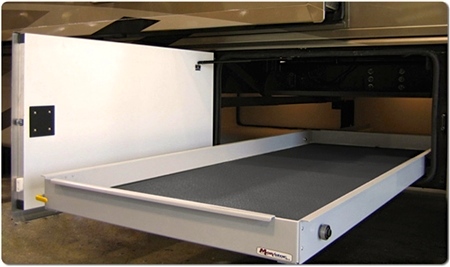
Sliding cargo trays come in different materials, sizes and strengths. They are sized for small cubbies, your RV’s largest external storage area, or cargo holds in between. With the variety of sizes, you can put a slider in half of your biggest storage area and leave the other part without one.
Put whatever you want on a slider, especially if it’s one of the heavy-duty models. The common-sense approach is to put frequently used articles on the slider, while leaving seldom-used items on a stationary surface. So, things like outdoor picnic tables and convenience tables, chairs and grills can go on the slider because they’re coming out almost as soon as you park and level off.
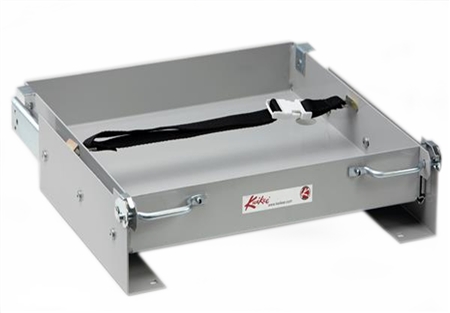
Sliders can ease maintenance. Battery arrays, your generator or an inverter can be placed on a slider, which makes troubleshooting a breeze. You may have to replace standard cables with longer examples so that they will not restrict the sliding action.
You can actually mount a gas grill and use the slider as a pullout cooking station. Think of the fold-down grills that are all the rage on new Class A and Class C motorhomes. Some have the grill only, others the grill and a flat work surface on one or both sides, and some a sink.
A grill mounted to a slider may not be as fancy, but it can be as functional. Metal sliders are the material of choice for grill-mounting. Full-width sliders allow space for cooking utensils, spices, sauces and plates in addition to the grill. You could also mount a small refrigerator/freezer next to your grill.
The nice thing is that you don’t have to lift the grill into place repeatedly; just mount it to the sliding tray once and pull it out for use, then slide it back after cleaning. Measure the height, mount a wooden table or box, then the grill to that surface. Without the need to lift your grill repeatedly, you just might be tempted to get a more elaborate grill that you once thought too impractical.
Small items are best placed in handled plastic tubs to keep them from scattering during travel. Just slide out the tray, lift out the tub and carry the contents to the spot where they’re needed. A good example is all of your cleaning products, including a rolled up hose and brushes.
You can buy sliders at RV dealers, or just slide over to your computer and order online. Expect to pay $250 to $750, depending on size and quality. If you’re handy, you can also buy materials and build one yourself. Find glides at the same sites that sell the finished products.
Here’s How To Keep RV Awnings Looking Good and Working Well
Written by MattNothing on your RV says “relaxation” more than your RV awning. You press a button to open it, take a seat in its shade, and probably — quite often — dine under it. And when you’re ready to hit the road, you just press a button again to retract it.
But even this relaxation station requires maintenance. Moving parts need lubrication periodically. And the fabric (usually woven vinyl) requires cleaning, removal of mildew, and application of a sealant/protectant — especially before long-term storage.
Clean the Awning First
You’ll want to clean your awning first. Always check your owner’s manual to make sure you are using chemicals that won’t harm it. Mildew builds up on an awning after it gets wet, and sometimes when it’s rolled up. So it’s good to use a product that contains bleach or a mildew fighter. An alternative is a mixture of a ¼ cup bleach and ¼ cup dishwashing liquid in a 5 gallons of water.
Things you’ll need, all of which you can buy at a home center:
- Old clothes and hat (bleach spots clothes and hair)
- Cleaning agent
- Bucket
- Hose and running water
- Applicator (garden-type pressure sprayer with a hand pump and resistance to damage from bleach)
- Long-handled soft-bristle brush or sponge
- Hand sponge
- Reading material (yes, really)
- Long-handled paint roller
- Sealant/protectant, such as 303 Products
Follow these steps:
- Open your awning.
- Check for color fastness on an area that’s out of view — near the top, where a strip of the fully extended awning faces the side of your RV.
- Mix the cleaning solution and pour into the sprayer.
- Hose down the top side of the awning. Use a garden sprayer to apply the cleaner. Hose off the bottom of the awning.
- Roll the awning to its travel position and wait 10 to 15 minutes while the solution works.
- Find some shade and read. (Didn’t I tell you?)
- Open the awning again. Rinse thoroughly with the hose and inspect. Scrub stubborn stains with the brush or sponge. If the awning appears still to be dirty, repeat Steps, 4, 5 and 6. Really dirty awnings may require a third application.
- Re-open and let dry. Once the awning dries, use the roller to apply the sealant/protectant.
- Allow protectant to thoroughly dry (sometimes up to 12 hours, less in direct sunlight), and keep it free of water until it does.
Awning Lubrication Ensures Smooth Operation
Now it’s time to lubricate. You’ll need two things:
- Silicone-based spray lubricant
- Rag or paper towel
Follow these steps:
- While your awning is open, spray the lubricant on moving parts: hinges, the ends of the awning roller, support arm pistons. Wipe off drips and runs with the rag/paper towel.
- Open and close the awning several times so the lubricant works in. Wipe any excess lubricant.
That’s it. You are now ready for weeks — maybe months — of enjoying your awning before having to do this again.
Until your next major cleaning, use a sponge to spot-clean soiled areas, such as bird droppings. If the awning gets a lot of use, do intermittent cleanings with a non-bleach cleaner, such as Simple Green. It’s not as harsh on the fabric. This biodegradable, natural concentrate eats through grease effortlessly.
RVs are as much a part of football as the forward pass. And so is tailgating, with stadiums in Georgia no exception.
The nationwide sports website Bleacher Report actually ranks colleges for their tailgating appeal, and it rates the University of Georgia as the No. 6 football tailgate experience nationally. USA Today ranks the University of Florida-University of Georgia tailgate in particular as the fourth best. It’s nicknamed “The World’s Largest Cocktail Party.”
But don’t just drive to any football stadium assuming that RVs will be welcome, that RV space is unlimited, or that you’ll be able to tailgate outside your RV. You might get tackled for a loss.
It’s best to go online or call and check out several things before you go:
- Are RVs allowed?
- Are advance reservations available?
- What is the RV parking rate? (It can top $100 — with no hookups.)
- Is overnight RV parking permitted, both before and after the game?
- Is RV tailgating permitted?
Here are some RV tailgating facts for major Georgia football sites:
University of Georgia, Athens
UGA sells RV parking permits in advance for parking near Sanford Stadium. The cost is $125 per game. RV permits for half the games were sold out in August. Trailers are permitted. Tailgating is allowed after 7 a.m. on game day. Grilling with gas is permitted only if gas is in disposable containers of 17 ounces or less. No deep frying. Tables, grills, chairs and awnings may not extend into adjacent parking spaces and may not block traffic lanes.
Georgia Tech, Atlanta
RVs with a permit can enter RV parking areas for Bobby Dodd Field at 5 p.m. Friday before a Saturday game. They can stay until noon on Sunday. Here’s the catch: Permits are sold for an entire season only and already are sold out for this year. You can get on a waiting list by calling 888-849-4849. Georgia Tech offers online help to RV owners in finding nearby privately owned lots that will accommodate them.
Atlanta Falcons, Georgia Dome
RV parking permits in the Yellow Lot are $80 per game on a first-come first-served basis. There are no advance reservations to park RVs for the Falcons’ NFL games. The Yellow Lot is closer to the stadium than the Marshaling Yard, also $80. The lots open five hours before kickoff. Tailgating is permitted, but deep frying is not. Tailgate parties must wrap up within two hours of the last down. Tents up to 8x10 feet are permitted. Traffic lanes must remain open to a 14-foot width. Trailers are not permitted.
While colleges usually limit actual stadium permits for RVs, you can go online to find nearby parking lots that accept RVs for games. It’s not unusual for some privately owned lots near any major college to accept RVs and/or trailers. Some even reserve a certain number of spaces for home-team fans and a certain number for away-team fans who are visiting.
There are also RV parks and resorts near many football sites that rent camping spaces on game weekends. It’s not uncommon to see tailgating activities at these locations. An advantage of renting these spaces is that hookups are available, while they typically not at colleges. Sometimes shuttles to the stadium are available.
There don’t appear to be any regulations against trash talking, but a warning if you like to brag and your team ends up losing: You may be eating crow at your post-game tailgate.
The drive to Crossing Creeks RV Resort & Spa — or any number of places you and your family may travel in your RV — requires keeping your children or grandkids busy.
A movie will take up a big block of time, but you’re going to need more than that. Here are some kids travel ideas, some of which require very little to keep everybody happy, and some of which require just a little imagination. They get everybody to interact.
- Plan interesting stops
Well ahead of time, look at a map, your GPS or Web sites to find good places to stop along your route. You’ll need to stop anyway, for rest and food. Make some of those stops interesting places. A petting zoo, a public garden, a park or maybe a small museum would provide plenty to talk about. Before the trip, print out facts about the sites or the history behind them to spur discussion off and on the road.
- Tell stories round-robin style
This can take up loads of time, and it’s fun for everybody. Pick a person to start the story. For instance: “Once upon a time, a boy was born — with wings. He could fly high and far. Then he went to school, where he was the only boy with wings …” Then the next person has up to one minute to continue the tale — and the next, and the next — until it ends. Sometimes stories will continue for two or more rounds. You will do another story — guaranteed. Give each person a turn at starting a story.
- Sing karaoke
Get karaoke discs online or at a store that sells CDs and take turns singing. Play the discs on a laptop and display the lyrics on your smart TV. A karaoke song sounds very much like the original pop song, but without the singer’s voice. It’s up to you and your kids to do the singing. The onscreen lyrics light up in time with the music. Just follow along and belt out a tune. Chances are your kids will know the songs already, but having the lyrics onscreen will inspire confidence. Add a microphone for even more fun. And don’t forget to clap or cheer for each performance!

(This is how karaoke lyrics will look on your TV, helping everyone sing along as the words light up in time with the music. You can buy discs with kids songs, pop and country hits, and songs of faith.)
- Make your kids discoverers
This is a fun way to get your kids to actually look out the windows while traveling. Look up places along your route and download photos of landmarks from Web sites. Print the pictures out, put them in folders, and give a folder containing all the landmarks to each of the kids. Don’t pick too many sites, and make sure they’re all in just a part of the route, so discoveries don’t take too long. The first person to spot a landmark gives the photo to Mom or Dad, Grandma or Grandpa — whoever is not driving. Place each photo of a discovery in a notebook or folder and mark down who saw it first. Give a quarter for each landmark found, or maybe a dollar to the winner. Talk about each landmark and the history behind it as it is discovered.
Turn your kids into discoverers. Print out Internet photos of historic places along your route, such as the Cotton Exchange Building in Augusta, to make rest stops interesting. Whoever “discovers” the building wins the point. (Wikipedia)
Before you know it, you’ll be saying, “We’re here!”
More...
Enjoy the Total Eclipse of the Sun this August 21st — Safely
Written by MattIf you’ll be at Crossing Creeks RV Resort & Spa the afternoon of Monday, Aug. 21, you’re in for some spectacular entertainment — a rare total solar eclipse.
Just about anyone in the United States will be able to see at least a partial eclipse if there’s no cloud cover. But only people in a 70-mile-wide swath from Oregon to South Carolina will be able to see the eclipse in its totality. Blairsville, Ga., home of Crossing Creeks, lies within that path.
The eclipse, from partial through full and then again through partial stages, will last up to 3 hours. It will begin about 1:07 p.m. It will reach totality about 2:37 p.m., making it look as if nightfall has arrived. You may not want to miss it: A total solar eclipse won’t be visible again in northern Georgia until 2078.
But be careful how you view the eclipse. I found information on safe viewing from the people who know a thing or two about heavenly bodies: NASA, the National Aeronautics and Space Administration. NASA says it’s safe to view the eclipse with the naked eye only in its total stage. The total eclipse — when the sun appears to be a black sphere surrounded by a bright aura — will last a mere 2 minutes and 40 seconds. Looking directly at the stages before and after the total stage can injure your eyes.
NASA recommends using eclipse safety glasses. These solar filters, held together by cardboard frames, are sold online and in discount stores for $4 to $5. Eclipse glasses meet the ISO 12312-2 international standard. The American Astronomical Society, part of the National Science Foundation, says the following manufacturers make certified eclipse safety glasses: American Paper Optics, Baader Planetarium (AstroSolar Silver/Gold film only), Rainbow Symphony, Thousand Oaks Optical, and TSE 17.
Make sure the glasses have no scratches or holes. Put them on before glancing at the sun, NASA suggests. Look away from the sun before removing them.
Warning: Normal sunglasses, no matter how dark, are not safe for viewing the eclipse. Even dark ski goggles are not safe. And NASA warns not to look directly though a camera or telescope unless equipped with properly fitting solar filters.
Here are two ways to watch indirectly:
- Get two sheets of heavy white paper. In one, punch a pinhole. With your back to the sun, hold the sheet with the hole up to the sun. Hold the second sheet so the light shines through the hole, hitting the solid sheet. You will see a real-time image of the sun on the solid paper.
- Use your hands to form a cross hatch, with tiny spaces between your fingers. With your back to the sun, hold them up so the sun’s rays shine through. A multiple image of the sun — and the eclipse — will form where the shadow of your hands falls. Look at the images, not directly at the sun.
You don’t need to climb up on your RV to see this show. There are air conditioning units, luggage racks and solar panels up there, and it’s a long, dangerous way down if you fall. You’re safer on the ground, unless your RV is set up to handle rooftop sitting.
Enjoy the show!
If you’re having a hard time looking around the web for a certain RV topic or solution and not finding what you’re searching for, you may want to check this list.
We created a list of the top 4 online resources where to find more information or tips to better enjoy your RV life.
RV Park Reviews
If you’re trying to compare one RV park or another and you can't find enough reviews online, this is the perfect website for your needs. With a very simple interface, you can pick the location and select the parks from the list. The reviews should be mostly accurate, but be sure to give more credence to the parks that have more reviews. This makes sure there is less manipulation by the owners. Then you can pick the best RV park for your next trip.
Mile by Mile Road Trip Planner
If you’re like most RV'ers and you like to plan the trip step by step ahead of time, you want to check this website. With more than 1,700 printable and downloadable highway guides it can help you study the fastest route and points along the route. It's always nice to have a printed map on hand if you don’t have a GPS or your go offline with no reception.
USCampgrounds
If you’re looking for the most comprehensive guide to Federal, State, Provincial and Local campgrounds this is the best website you can find. It covers all the 13,000 US and Canada public campgrounds with accurate details for each. Also, it’s very easy to use as the website is based on an interactive map showing all the camps and with a simple explanation next to it.
TV Fool
Are you one of those people that can’t live without knowing which movie is coming on next? Well, we have a website for you. Here you can find a tool to analyze your location and it tells you which broadcasters are transmitting locally, which direction you should point the antenna, how strong is the signal in your area and the list of available channels. A great resource that moves with you.
If you just purchased a new RV and you’re enjoying your time on the road but you feel that something is missing, well you may want to think about an upgrade.
When you’re on the road for a long time, you just start feeling that you're missing creature comforts from home. We made a list for you of the best 10 upgrades you may want to consider to make the RV experience more enjoyable.
Extra Battery Capacity
This upgrade may not be seen as important but imagine yourself excited for a new excursion to a National Park but with no electric hookups near the area. If you’re considering staying at an RV Park you can leave in the morning and be back in the evening but if you want to stay out exploring for few days, you really need some extra power. This can be accomplished by purchasing extra batteries and linking them to your power supply system As an alternative you can also install a solar battery charging system to the vehicle.
Vent Fan
Driving in the sun all day can get hot, even with the AC pumping. If the sun is beating down on you it can be even worse. In addition, the RV may retain the smell of a recently cooked meal or even the smell of your wonderful pets. A roof vent fan is the simple solution. There are many options in terms of price, size, and complexity. The most well known brand is Maxxair.
TV Signal Booster
If you really don’t want to miss your favorite tv show while on the road and you’re worried about the constant weak reception of your current antenna, you may want to consider a signal booster. It can help you increase the signal strength, the channel reception, and the image quality. The Wingard Wingman Booster is our choice as it’s easy to install and it works immediately.
Digital Thermostat
If you’re finding yourself having trouble sleeping due to summer heat or just finding the perfect temperature inside your motorized home, you may want to think about a digital thermostat. The precise control of the temperature is life saver when you’re on the road for more than few days. Also, it doesn’t require you to invest too much money as there are many cheap and reliable options on the market.
LED Lighting
If you’re looking for a better, longer lasting source of light then LED lighting should be the first option to consider. This comes with many advantages such as improved visibility, safety, and a modern look.
When purchasing LED lights be aware that if you go with the cheapest option. You may find yourself with a low-quality product with no built in regulation circuitry and a not so bright color. To start thinking about it, you may want to take a look at http://www.starlightsinc.com/.
Travel Trailer, Fifth Wheel and MotorHome Comparison. How to Choose the Best RV For You?
Written by MattSo your imagination is in high gear, fantasizing about visiting parts of the country you’ve only flown over. Now you’re ready to visit each of those spots, stopping along the way to make sure nothing is missed.
Well, joining the RV community will help you make it happen. But first, you should ask yourself if you know what kind of RV would be best for you. There are so many types of RVs in the market that someone with no experience or first-time owners could end making a big mistake.
You could choose an RV that doesn’t fit your needs or end up just paying too much.
Here at Crossing Creeks RV Resort, we made a comparison of the leading top 3 choices of RVs in the market based on your goals and price range:
Travel Trailer
These RVs are pulled behind your vehicle and not permanently connected. They range in size from 12 to 35 feet with a cost between $8,000 and $90,000. We recommend an SUV or other 4 wheel drive vehicle to tow the trailer, to make sure the vehicle's brakes and drivetrain can support pulling this load.
One of the main benefits of the travel trailer is surely the cost. You can end up saving a lot of money and have almost the same features of a smaller motorhome regarding living space and amenities (Up to 10 people). Also, travel trailers tend to hold their value for a longer time.
One thing to be careful about is the fact that these are not as easy to drive as you may think. You need to be aware of the fact that the trailer can move and shift on the road as you’re driving, especially at highway speeds. So you need to stay focused with no distractions. For longer drives, be sure to share the driving responsibility with others who are fresh.
Fifth Wheel RV
Fifth Wheel RVs are also pulled behind your vehicle and not permanently connected. They range in size from 21 to 40 feet with a cost between $16,000 and $160,000. They need a full size truck with a bed or other 4 wheel drive vehicle to tow the trailer.
The Fifth Wheel option may be considered as the “Luxury” option when it comes to trailer selection. This vehicle can offer so many features and services and makes you feel like you’ve never left home.
Make sure to find lots of places to stop along the way so you don’t find yourself behind the wheel too long, as the heavy vehicle will surely keep your speed down. You also may be wondering about stability and safety. Good news is shifting and swaying are minimal, so you can enjoy your ride without any added stress.
MotorHome
MotorHome RVs are self-sufficient vehicles that don’t require a tow. They have their own engine, drivetrain, all integrated perfectly with the living area of the RV. They range in size from 21 to 40 feet with a cost between $60,000 and over $500,000. Some musicians and other high profile people who have to travel a lot can configure their Motorhome so that it costs over $1,000,000!
If pure luxury is what you’re looking for, MotorHomes are the best option. Space and amenities are top notch: a full kitchen area, separate bedrooms and other upgrades such as entertainment zones. These luxurious rolling homes are great for travelers who want all the creature comforts without having to worry about hotels and towing their own vehicle.
In the next blog post, we will make a comparison of the best MotorHomes models so that you can understand how to pick the right one for you. Let us know which specific model you would like us to review, and we will take it into consideration!
